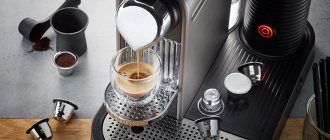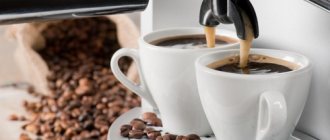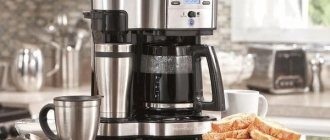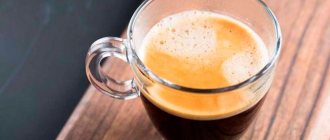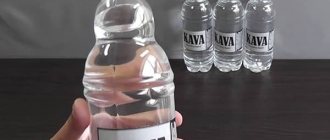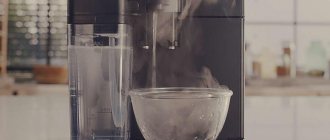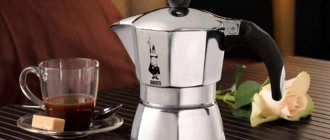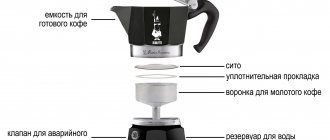As I already wrote (see the review article about choosing a coffee maker for the home on the main page), "drip coffee makers", they are filtration – the most affordable devices on the coffee equipment market. The choice of a real "state employee". Therefore, many people buy them without even looking at them. And then they get disappointed very quickly. I am also familiar with numerous opposite cases. The person didn’t even look in the direction of drip coffee makers, he thought, well, for that kind of money it definitely won’t make me normal coffee, but in the end it turned out that a drip coffee maker/coffee machine is the ideal solution for him.
To understand who filter coffee makers are suitable for and who are contraindicated, we will first study their design, because all the conclusions logically follow from the method of preparing the drink.
What is a drip coffee maker, how does it work?
Drip coffee maker diagram
The design of drip coffee makers is the most primitive among other electrical appliances for brewing coffee. There is a heater combined with a stove on which the coffee pot stands, a water tank (usually at the back, filled from above), and a compartment for putting coffee (usually above the coffee pot, filled from above). Actually, that's all. Well, plus a small control board, which is largely absent in simple models with a single on/off button.
Water from the tank enters the heater, heats up and, in the form of a water-steam mixture, rises by gravity through the tube into the compartment with coffee, where the steam condenses and flows in drops into the coffee, where, seeping through it under natural pressure, without any pressure, it flows into the coffee pot . A simple drip coffee maker does not have any pumps or complex valves.
After all the water has flowed into the coffee pot, the heater, which is combined with the coffee pot heating plate, continues to work, preventing the coffee in the jug from cooling down. But the operating temperature of the heater is selected so that it does not burn out without water supply, this is one of the reasons why the heating plate always works weakly, and initially not very hot coffee (coffee is not brewed with boiling water in principle) cools down even when the heating is operating.
Cook only with high quality water
Say a categorical “No!” to unfiltered tap water. Impurities included in the composition will negatively affect the taste of the finished drink.
Try to pour water into the reservoir in a thin stream. This method helps saturate it with oxygen, which has a beneficial effect on the quality of the drink.
Poor quality water, when combined with the elements contained in a disposable filter, can give an unpredictable result.
Who is it suitable for?
First, it is necessary to clearly understand that a drip coffee maker prepares only one type of drink - filtered coffee. This is neither Turkish coffee, nor from a geyser, much less espresso. And all sorts of cappuccinos are also missing.
A drip coffee maker prepares one type of coffee – filtered, which can also be called a real “Americano”.
Therefore, those who are disappointed after a purchase usually expect to get something noticeably stronger than from a French press or pouring boiling water from a kettle over ground coffee in a cup. But in fact, such equipment is simply not intended for brewing a drink of at least a geyser level of saturation.
But this is exactly the original recipe for making the “correct” Americano. It’s not for nothing that in America, both North and South, finding coffee other than filtered can be extremely difficult. That is, if you are a fan of this particular type of coffee drink, then your choice is a drip coffee maker. If you only drink Americano, then buy an espresso coffee machine or a carob pump coffee maker, then dilute the drink with hot water - shoot sparrows from a cannon. Taking into account the fact that drip coffee makers start from 1-2 thousand rubles.
A little history
The prototype of the modern drip coffee maker dates back to 1800. A French archbishop came up with the idea of brewing coffee by passing hot water through a filter with ground coffee beans. This device consisted of two interconnected vessels (for water and ready-made coffee), between which a filter was placed. Modern drip coffee makers work on the same principle.
Electric drip coffee makers appeared in the mid-20th century in the United States. And very quickly they became the peak of popularity. Americans believed that filter coffee had less caffeine and was less harmful to health. Although, in fact, it contains more caffeine than “strong” ristretto or espresso. The more coffee comes into contact with hot water, the more caffeine it contains. And the process of preparing filter coffee involves prolonged contact of ground coffee with water.
Today, filter coffee is popular not only in the United States, but also in many other countries. For example, residents of Finland, who drink more coffee than residents of other countries, drink an average of 5 cups of filter coffee per day.
What does taste depend on, and which coffee maker makes coffee taste better?
Typical drip coffee maker
With the filtration brewing method, it is extremely difficult to somehow influence the taste of coffee using technical tricks. What and how much coffee you put in the filter is what you get out of it. Therefore, in most home drip coffee makers, the taste will be the same, provided that the same coffee is used in the same quantities and the same amount of water is poured.
It is clear that manufacturers often try to apply some kind of textbook marketing and declare something “revolutionary” like “AromaSwirl” or “gold filter”, but in 99% of cases this is nothing more than marketing and does not affect the taste.
More often, the opposite option occurs, either to save money, they make a small or crooked compartment for ground coffee, or they incorrectly place the water outlet (supply) tube in the coffee above this compartment. The error may be a very close or off-center position, or there may be only one hole that is too narrow in the tip of the feed nozzle. As a result, water enters the filter with coffee unevenly over the area and it turns out that part of the coffee is simply not used.
According to my observations, this can only be the fault of a “Chinese” brand of “second-class” of dubious origin (examples: Polaris PCM 0109, Vitek Grace, Redmond RCM-1501); I have never seen such flaws in any famous manufacturer.
If everything is fine with the coffee maker, it does not have the “finds” described above, then for an exemplary result it is necessary to use the appropriate coffee and the correct grind. As usual, no one canceled freshly roasting and grinding immediately before preparing the drink; this significantly improves the taste. By grinding, as well as by the amount of coffee and water, you can regulate the taste, strength, and richness.
The finer the grind, the more coffee and the less water spilled, the richer and stronger the drink will be. The coarser the grind, the less coffee in the bookmark and the more water spilled - the lighter and more drinkable. The “gold standard” is 60 grams of ground coffee per liter of spilled water. Or 12 grams per 200 ml.
Keep in mind that all drip coffee makers (at least those that I know of) spill all the water poured into the tank through the coffee until you manually turn them off.
Temperature issue
But there are still some technical parameters that improve the taste of filter coffee in a coffee maker.
The nuance is that they go out into the arena only in really expensive coffee makers. This is primarily temperature. Both its absolute value and thermal stability. There are two camps of coffee makers: 95% are relatively simple and cheap, roughly, up to 10 thousand rubles. Not only do they not reach a temperature of even 90 degrees at their peak, but they also reach these values by the end of cooking, showing a good “comb” along the way. I showed an example of the temperature profile of a “cheap” drip coffee maker in comparison with an advanced one in the Wilfa Svart Precision review, but this indicative graph is worth posting here: Line Chart Infogram
Yes, this Vilfa is an example of the remaining 5% of devices that are literally an order of magnitude more expensive, but which can produce a stable temperature curve almost from the very beginning of cooking. This radically improves the taste, but I will not give you a 100% guarantee that you personally will appreciate these improvements for such a difference in price. Another good example of such an advanced coffee maker is the Moccamaster KBG741. The second parameter is the speed of the strait. It should not be very fast or very slow. Around 2:30 minutes per half liter, including dripping the remaining coffee from the funnel into the jug.
This mokamaster is notable for the fact that it has two pour speed modes, and in the second, slow one, the time reaches 3 minutes (for the same 500 ml), which allows you to additionally reveal some varieties (but this is not beneficial for all coffees). There are also devices that are intermediate in price, for example the Bonavita drip coffee maker - it costs about 15-17 thousand rubles. On the one hand, it cooks better than the “basic” ones, but on the other, the difference in taste is not as noticeable as in the case of Wilfa or Moccamaster. And the likelihood that such a still significant amount will be spent without tangible results that are noticeable to you personally is high.
Advantages and disadvantages
Drip coffee machines have the following advantages and disadvantages :
- Low cost . Compared to capsule or carob coffee machines, drip coffee machines are much more accessible for use at home for many categories of the population.
- Lightweight and easy to care for and use. The operating principle of the coffee machine is simple. Therefore, operation and maintenance will also not be difficult.
- Possibility of preparing several servings of drink at once . This machine is suitable for a close-knit family with a large number of coffee lovers.
- Presence of heating function . You can prepare several servings of the drink without worrying about it getting cold soon. In addition, you do not need to load the necessary ingredients into the coffee maker every time.
- In addition to aromatic coffee, you can also make tea in a drip coffee machine .
- There is no grounds left in the finished coffee .
As for the disadvantages and disadvantages of a drip coffee maker, these include:
- needs to be changed regularly .
- must be washed after each use .
- Not very hot and not too strong coffee . But in this case, it all depends on individual preferences, because some people may consider these parameters to be advantages.
- Large consumption of ground coffee . It’s too financially expensive for lovers of elite varieties of the drink.
- After preparation there is no creamy foam , which many coffee lovers really appreciate.
Compared to the advantages of drip devices, the disadvantages are not so significant for some people.
That's why you need to know the functionality and operating principle of the device before purchasing .
Drip coffee machines with built-in coffee grinder
The coffee makers mentioned above are great. But there is absolutely no point in them if you do not use freshly ground beans, and even better, freshly roasted ones (catalog of Russian roasters here). Therefore, first of all, if you really set your sights on a high-quality filter, I advise you to pay attention to a tool for grinding beans - a coffee grinder (I have more information about choosing a coffee grinder here). Moreover, you will need milk for the same Vilfa.
At the same time, there are several household drip coffee machines on the market that are equipped with a built-in coffee grinder and grind the beans immediately before brewing. These are automatic drip coffee machines, they do everything with one click, and are even equipped with timers for preparing coffee at a certain time. For example, Philips HD7767/HD7769 Grind & Brew (an excellent machine with adjustable grinding degree) and REDMOND SkyCoffee M1505S (the coffee grinder, of course, is weak and the quality is poor, but it can be controlled from your phone). But in general, in terms of price/quality, I would advise you to take a closer look at Mystery MCB-5125/Gemlux GL-CM-55/Kitfort KT-705:
Features of filter coffee makers
- The ability to provide a stable water temperature throughout the brewing process. It is very important that the brewing does not involve water that has been or is currently undergoing boiling - oxygen comes out of the water, an important element in creating a tasty cup. In addition, brewing occurs many times faster, and your coffee can be overextracted (overbrewed), as a result of which bitterness will dominate the taste.
- Make the flow of water more uniform - relative to a coffee tablet (“shower”)
- Brewing in a jug that stands on a heating station or in a thermos.
- Possibility of connecting a water tank to the water supply through a filter.
Philips HD7767 Grind & Brew
